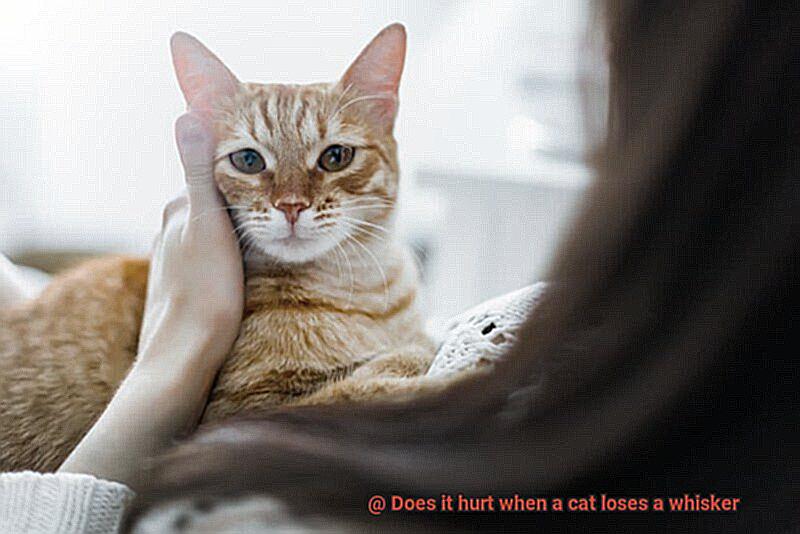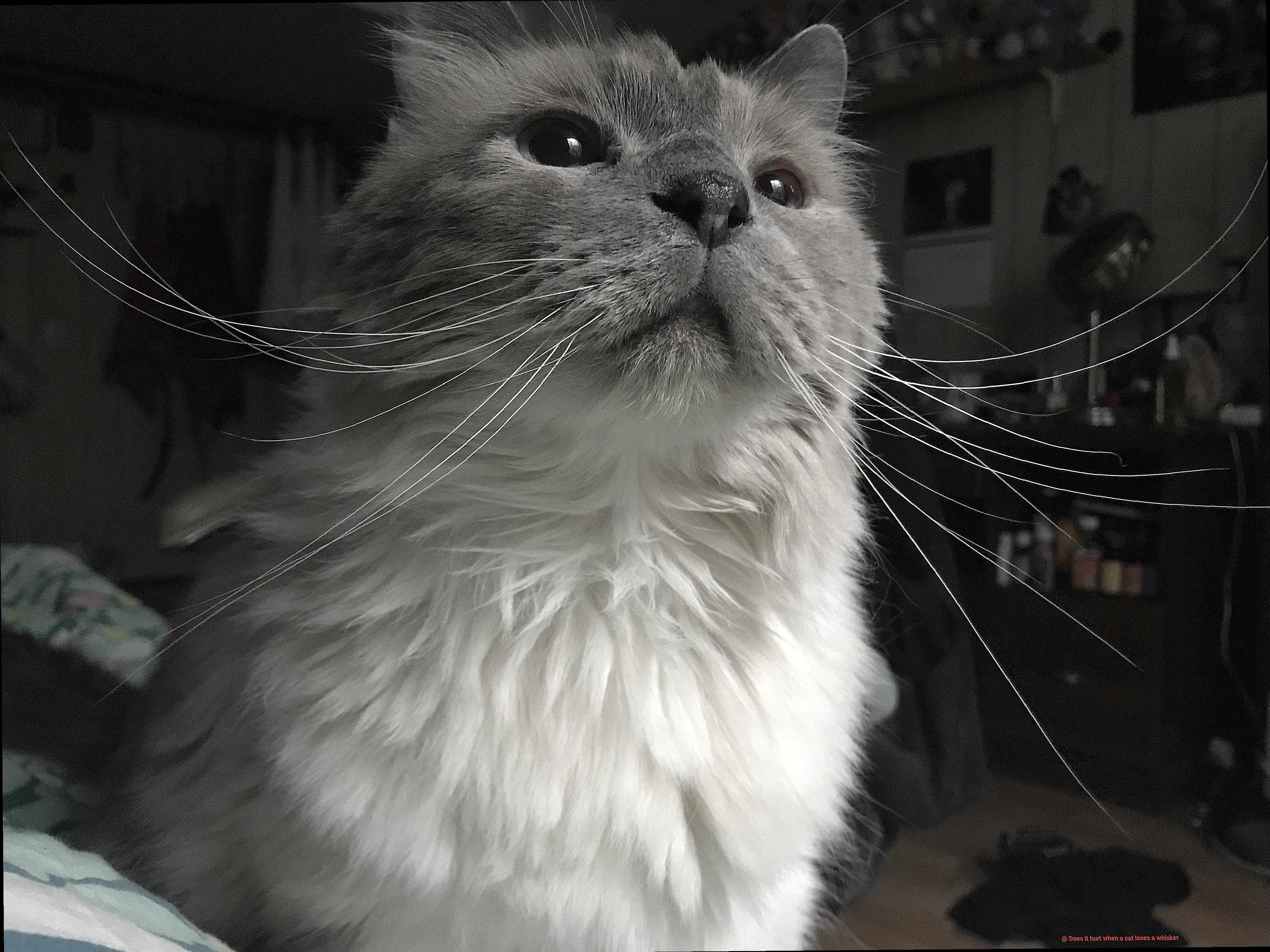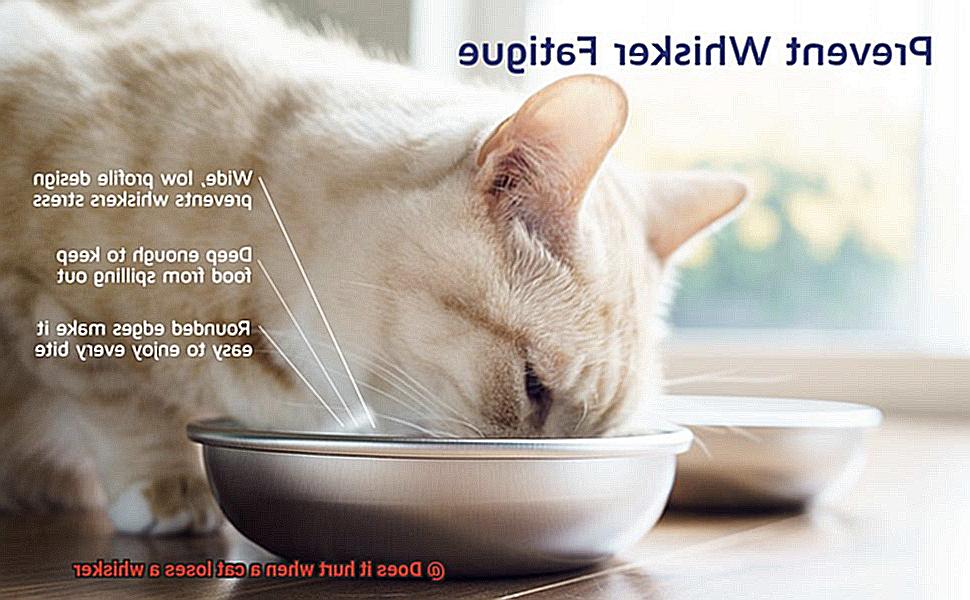Have you ever pondered whether it hurts when a cat loses a whisker? As a devoted cat lover and owner, this question has certainly crossed my mind. Whiskers, also known as vibrissae, are not just adorable little hairs that enhance a cat’s charm. They are specialized tactile hairs that play a significant role in a cat’s daily life.
Whiskers are deeply rooted in a cat’s face and serve as more than just grooming tools. They are essential for their spatial awareness, enabling them to navigate through tight spaces and detect nearby obstacles. Additionally, whiskers can be used to measure distance, allowing cats to make precise jumps and landings. Furthermore, they are incredibly sensitive to movements, vibrations, and even air currents, providing cats with an added sense of security and warning of potential danger.
But what happens when a cat loses one of their precious whiskers? Is it painful for them? Will they grow back? In this blog post, we will take an in-depth look at the world of whiskers and address all the common questions that arise. We will explore the anatomy of a whisker, why they fall out naturally or due to injury or illness, and most importantly – if it causes any discomfort when they do.

So let’s dive deep into this fascinating topic and learn more about our feline friends’ incredible sensory system. Whether you’re a seasoned cat owner or just curious about these magnificent creatures’ unique traits – get ready to discover everything you need to know about whether it hurts when your kitty loses one of their precious whiskers.
What are Whiskers?
Whiskers, or vibrissae, are much more than just long hairs on a cat’s face. These specialized sensory organs are deeply rooted in a cat’s skin and can be found in specific locations, such as above their eyes, on their chin, and around their nose. They may look like ordinary hairs, but they serve an incredibly important purpose.
Cats use their whiskers to navigate their surroundings and detect changes in the air. Each whisker is connected to a cluster of nerves that send signals to the cat’s brain, allowing them to determine the location, size, and movement of objects around them. Whiskers also help cats judge distances, navigate in the dark, and avoid obstacles. In short, whiskers help cats stay safe and alert.
It is crucial to note that not all whiskers are the same. Each type of whisker serves a different purpose and provides unique sensory information to the cat. For example, the whiskers above a cat’s eyes are shorter and more curved than the ones on their chin. This allows them to detect movements on a smaller scale.
Losing one or more whiskers may seem alarming, but it is a normal and painless process for cats. Whiskers can fall out naturally or due to grooming, injury or other reasons. However, losing too many whiskers can lead to disorientation and difficulty moving around. As pet owners, we should monitor our cats’ whisker health and ensure their environment is safe from potential hazards.
Reasons for Cats Losing Whiskers
As cat owners, we know that our furry friends use their whiskers for more than just looking cute. These specialized hairs are sensory organs that help cats navigate their surroundings with ease. But what happens when these whiskers start to disappear? Let’s explore the various reasons why cats may lose their whiskers.
Shedding
Just like with fur, cats shed their whiskers as part of their natural grooming process. This is nothing to worry about, as the whiskers will grow back in time. So, if you see a stray whisker on your carpet or furniture, don’t panic.
Trauma: Cats are curious creatures and love to explore their environment. Unfortunately, this can sometimes lead to accidents and injuries. If a cat gets into a fight with another animal or bumps into something while exploring, their whiskers may become damaged or broken, leading to loss.
Medical conditions
Cats may lose their whiskers due to underlying medical conditions such as feline acne, skin infections or allergies, hormonal imbalances, and nutritional deficiencies. These conditions can cause hair loss in cats, including the loss of their sensitive vibrissae.
Age
As cats grow older, they may start to lose their whiskers more frequently. This is because their whiskers become brittle and break off more easily as they age. However, this is a natural part of the aging process and not necessarily a cause for concern.
Stress or anxiety
Just like humans, cats can experience stress and anxiety that can manifest in physical symptoms such as hair loss. If a cat is feeling anxious or stressed, they may chew or excessively groom their whiskers which can lead to them falling out.
It’s important to note that while losing a few whiskers here and there is normal, excessive or sudden loss of multiple whiskers may be a cause for concern. If you notice your cat losing an excessive amount of whiskers or if the loss is accompanied by other symptoms such as skin irritation or lethargy, it’s important to consult with your veterinarian.

In the meantime, there are steps you can take to help prevent unnecessary whisker loss. Regular grooming and keeping your cat’s environment safe and free from hazards can help keep their sensitive sensory organs in good health.
Remember, cats may not even notice when they lose a whisker, but it’s up to us as responsible pet owners to ensure their well-being at all times.

Do Cats Feel Pain When They Lose a Whisker?
These vibrissae, as they are scientifically known, are not like regular hairs on a cat’s body. They are deeply rooted in the skin and surrounded by nerve endings, which gives them their sensitivity.
Cats use their whiskers for more than just looking cute; they play a crucial role in their daily life. These specialized hairs help them sense their surroundings, navigate tight spaces, and hunt prey.
You may have noticed that cats use their whiskers to judge whether they can fit through a small gap or not. This is because the whiskers are so sensitive that they can detect even the slightest change in air currents.
However, if a cat’s whisker is cut or broken, it can cause discomfort or even pain. This is because the nerve endings surrounding the whisker are exposed and can be stimulated by touch, causing the cat to react with a flinch or swat.

We should avoid cutting or breaking our cat’s whiskers, as it can disrupt their ability to sense and navigate their environment effectively.
Is It Normal for a Cat to Lose a Whisker?
As someone who has spent years studying cats and their behaviors, I can tell you that losing a whisker is a completely normal occurrence. Whiskers, or vibrissae, are made of keratin, the same protein that makes up human hair and nails. They play an important role in helping cats sense their surroundings and are deeply rooted in their skin.
Cats shed their whiskers just like they shed their fur. As they grow and age, their whiskers may fall out and be replaced by new ones. Typically, adult cats have around 12 whiskers on each side of their face, with additional whiskers above their eyes and on their chin. So if you discover a stray whisker on your couch or floor, rest assured that it’s just a sign that your feline friend is growing and changing.
It’s important to note that cats have a limited number of whiskers. If your cat loses one or two, there’s no need to worry – they will simply grow new ones in their place. However, if you notice an excessive amount of whiskers falling out or other symptoms such as skin irritation or hair loss, it’s best to consult with your veterinarian to rule out any underlying health issues.
How Does the Loss of Whiskers Affect a Cat’s Ability to Navigate?
They are sensory organs that are vital for cats to navigate their surroundings with ease. In this article, we will dive into the importance of whiskers and how the loss of whiskers can affect a cat’s ability to navigate.
Whiskers are long and stiff hairs that contain sensory receptors at their base, which detect even the slightest changes in air currents, pressure, and vibrations. These sensory tools act as an extension of a cat’s nervous system, providing valuable information about their environment. Without whiskers, a cat may struggle to move around effectively and become disoriented.
The roots of whiskers are rich in nerve endings, making the loss of whiskers a painful experience for cats. Additionally, the loss of whiskers can impair their ability to gauge spatial distances accurately, leading to clumsiness and difficulty with depth perception. It is crucial to take measures to prevent accidental damage or removal of whiskers, as it can cause discomfort and disorientation.
Whiskers play an essential role in a cat’s hunting ability by helping them determine the size, location, and movement of prey. With whiskers, cats can pounce and catch their target with ease. Without them, a cat may miss their prey or struggle to hunt effectively.
As a responsible pet owner, it’s important to ensure that your cat’s environment is safe and free from potential hazards that could damage their whiskers. If you notice a significant amount of whiskers falling out or any other concerning symptoms, it’s best to seek guidance from your trusted veterinarian. They will be able to assess your cat’s health and provide appropriate treatment if needed.
Tips for Maintaining Healthy Whiskers
Whiskers are more than just a cute feature on a cat’s face. They play a crucial role in their sensory system, helping them navigate through dark and unfamiliar environments by detecting changes in air currents.
That’s why it’s essential to maintain healthy whiskers in cats. Here are five tips to ensure your furry friend’s whiskers stay healthy and functioning properly.
- The first tip is regular grooming. Just like us humans need a good hairbrushing, cats need regular grooming to prevent tangles and matting that can cause damage to their whiskers. Use a soft brush to gently groom your cat’s whiskers and remove any dirt or debris that may have accumulated. Not only will this help keep their whiskers healthy, but it also provides a bonding experience between you and your cat.
- The second tip is to avoid trimming your cat’s whiskers. Cutting them can cause discomfort and even affect their balance. Whiskers are highly sensitive sensory organs, and they work together with their eyesight to keep them safe and aware of their surroundings. So, resist the urge to trim those cute little whiskers.
- The third tip is to provide a balanced diet. A healthy diet helps maintain the overall health of your cat, including their whiskers. Make sure you’re providing your cat with all the necessary nutrients they need to keep their whiskers strong and healthy. This means feeding them high-quality food that’s packed with protein, vitamins, and minerals essential for their well-being.
- The fourth tip is to keep stress levels low. Stress can cause hair loss, including the loss of whiskers. Keeping your cat’s stress levels low by providing a calm environment and regular playtime can help prevent hair loss, including whisker loss. Create a peaceful space for your cat to relax in, provide them with toys and scratching posts, and spend regular quality time with them to help reduce their stress levels.
- Lastly, regular veterinary check-ups are essential. Your vet can check for any signs of damage or infection in your cat’s whiskers and provide treatment if necessary. They can also give you advice on how to maintain healthy whiskers and answer any questions you may have.
Conclusion
To sum up, whiskers are not just adorable features that add to a cat’s charm. They are specialized tactile hairs that help cats navigate their surroundings and detect potential dangers. Whiskers are incredibly sensitive to movements, vibrations, and air currents, providing cats with an extra sense of security.
While losing one or two whiskers is a natural process for cats and does not cause any pain or discomfort, excessive loss can lead to disorientation and difficulty moving around. As responsible pet owners, we should keep an eye on our furry friends’ whisker health by providing proper grooming, avoiding trimming the whiskers, ensuring a balanced diet, reducing stress levels, and scheduling regular veterinary check-ups.
Overall, it is essential to understand the significance of whiskers in a cat’s sensory system and take steps to maintain their health.

